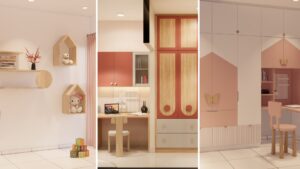Indian interior design, deeply rooted in a rich cultural heritage, draws inspiration from centuries-old traditions and a diverse range of regional influences. This timeless artistry is characterized by vibrant colours, intricate patterns, and handcrafted elements that create spaces exuding warmth, cultural depth, and timeless allure. At Tesor Designs, we take pride in incorporating these soulful elements into our modern interiors, seamlessly blending tradition with contemporary aesthetics.
The Essence of Indian Heritage Interiors
1. Rich Color Palettes
In Indian culture, colours are more than just aesthetic choices; they symbolize emotions, spirituality, and celebration. Indian interior design embraces a vibrant colour palette, often featuring jewel tones like deep purples, rich blues, emerald greens, and striking reds. These colours not only add a sense of grandeur and luxury to spaces but also evoke a deep emotional connection.
For instance, a living room adorned with rich blue walls, complemented by emerald green upholstery and golden accents, can create a regal yet inviting atmosphere. Incorporating such vibrant colours can transform any room into a space of elegance and cultural significance.
2. Intricate Architectural Details
Indian interiors are renowned for their elaborate architectural details. Elements such as intricate carvings, arched doorways, domes, and ornate columns showcase exquisite craftsmanship and add cultural richness and historical significance to modern homes.
One can incorporate these details into contemporary interior design by using carved wooden panels as room dividers, arched windows to frame beautiful views, or ornate columns to add a touch of traditional elegance. These elements not only enhance the aesthetic appeal but also infuse the space with a sense of heritage and opulence.
3. Luxurious Fabrics
Fabrics play a crucial role in Indian interior design. Every region in India produces unique textiles that tell their own stories. Luxurious fabrics such as silk, velvet, brocade, and embroidered textiles are used for upholstery, curtains, and draperies, adding a regal elegance to the overall design.
For example, silk drapes with intricate embroidery can add a touch of luxury to a luxury bedroom, while a velvet sofa can become the centrepiece of a living room. These fabrics not only enhance the visual appeal but also provide a tactile richness that elevates the comfort and elegance of the space.
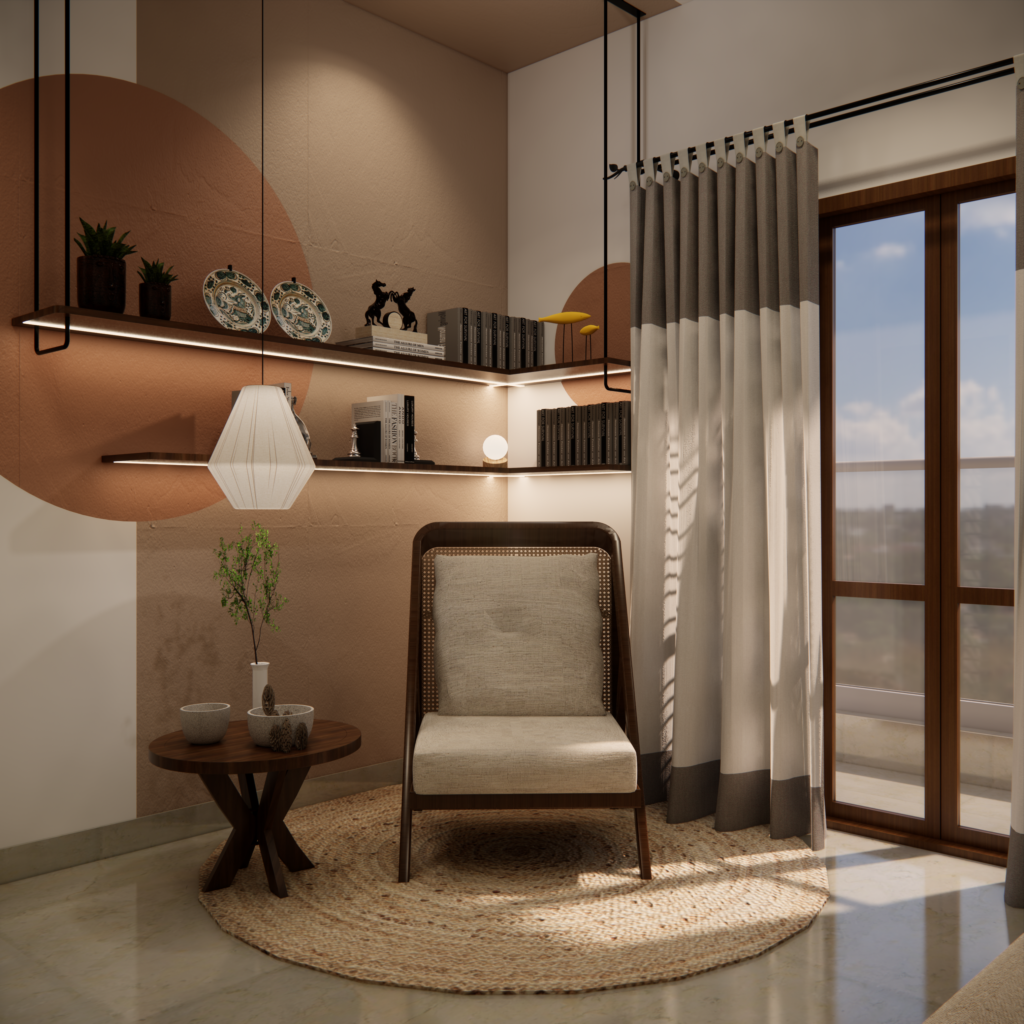
4. Handcrafted Furniture
Indian furniture is distinctive for its intricate craftsmanship. Traditional techniques like hand carving, inlay work, and elaborate motifs are commonly used, often incorporating rich woods like rosewood, teak, or mahogany. These pieces are adorned with brass or mother-of-pearl inlays, creating furniture that exudes cultural heritage and timeless elegance.
A hand-carved wooden coffee table or an inlaid cabinet can serve as stunning focal points in a room, adding both functional and aesthetic value. These handcrafted pieces bring a sense of history and artistry, making each piece unique and significant.
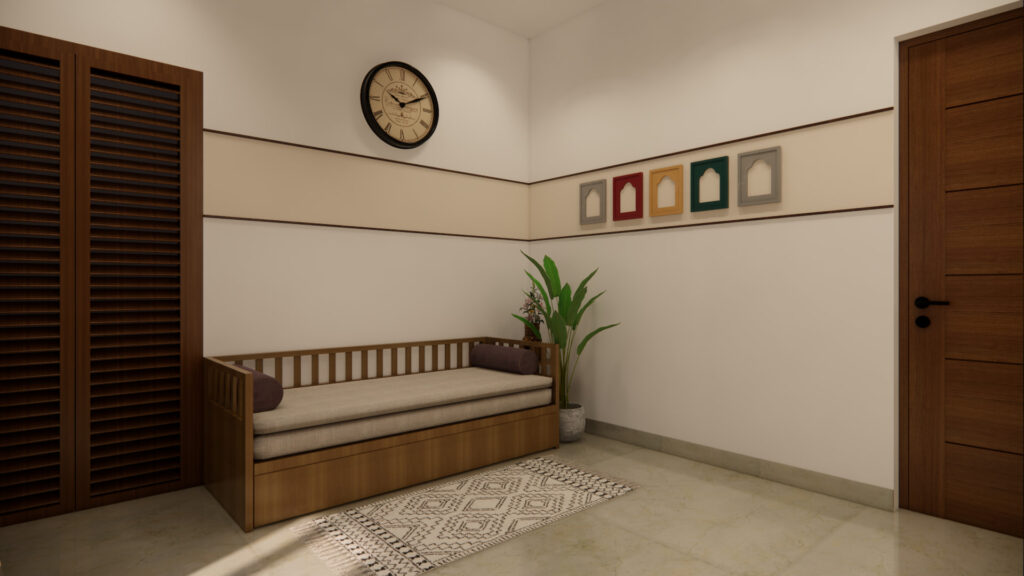
5. Traditional Art and Decor
Art and decor are integral to Indian interior design. Traditional Indian art forms such as miniature paintings, intricate wall carvings, and detailed weaves adorn the walls, adding a personalized touch and celebrating the rich tapestry of Indian art.
Incorporating a mural or a fresco depicting historical scenes or mythological stories can create a visually captivating and culturally rich environment. Similarly, using traditional wall hangings or framed textiles can add depth and character to the space.
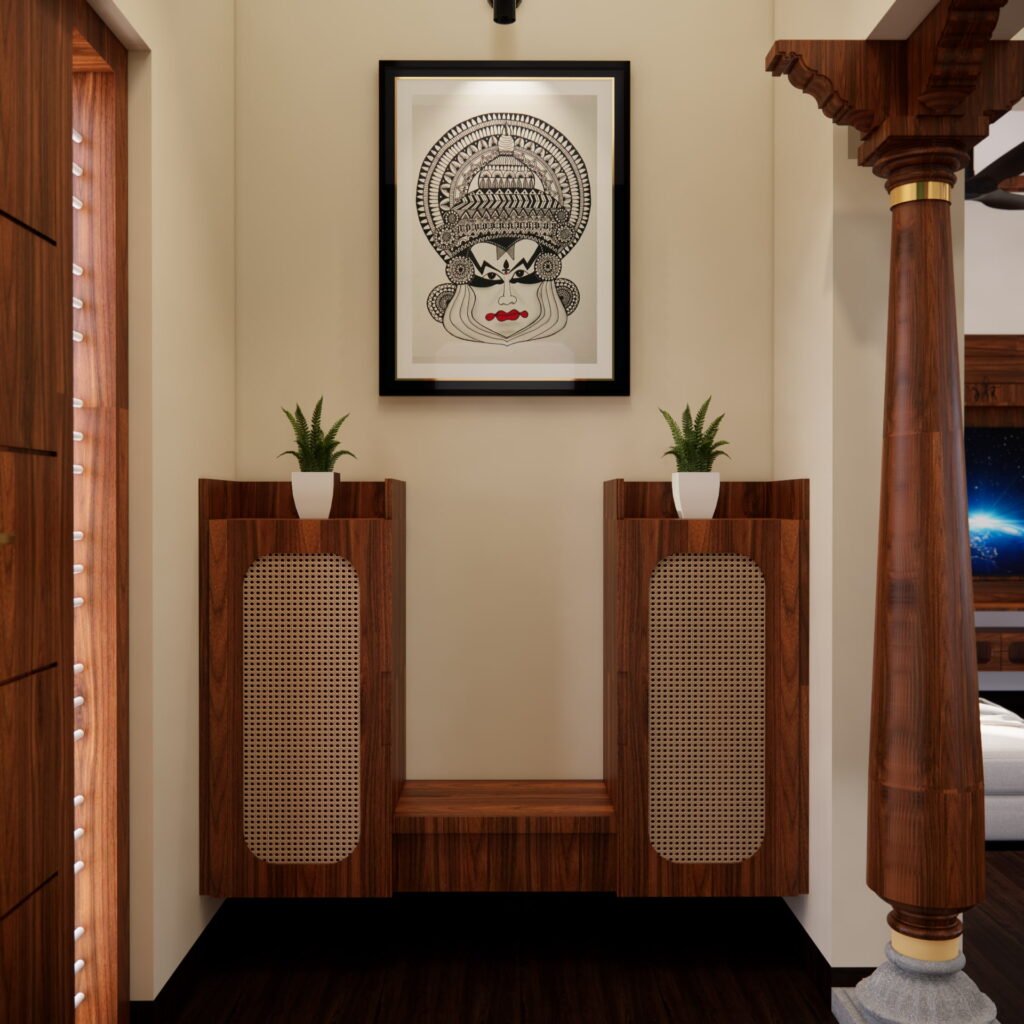
6. Grand Chandeliers and Lighting
Lighting is a crucial aspect of Indian interior design. Detailed lighting fixtures and chandeliers made of brass, copper, or crystal are hallmarks of this style. These fixtures often feature cultural motifs like lotus flowers or peacocks, creating a sparkling, opulent atmosphere.
A grand chandelier in the dining room or intricately designed brass lamps in the living room can elevate the ambience, adding both light and elegance. The interplay of light and shadow created by these fixtures can enhance the overall aesthetic and mood of the space.
7. Marble and Inlay Work
Marble is extensively used in Indian interiors for flooring, countertops, and accents. Known for its luxurious appeal and unique veining, marble enhances the sophistication and timeless beauty of spaces. Inlay work, often seen in traditional Indian palaces and temples, adds an extra layer of intricacy and elegance.
Using marble flooring in the foyer or an inlaid marble countertop in the kitchen can bring a touch of grandeur and refinement. These elements not only add to the visual appeal but also signify the rich cultural heritage and craftsmanship.
8. Royal Patterns and Motifs
Indian patterns and motifs, such as mandalas and paisley designs, are integral to this design style. These patterns are often found in textiles, rugs, and decorative items, adding vibrancy and cultural significance to the space.
Incorporating these motifs through ornate wood carvings, brass accents, and handwoven rugs can create an authentic Indian-inspired ambience. A paisley-patterned rug or a mandala wall art can become the focal point of a room, enhancing its aesthetic and cultural depth.
9. Luxurious Drapery and Canopies
Canopy beds, draped in luxurious fabrics with elaborate curtains adorned with tassels and trims, create a sense of grandeur reminiscent of royal history. These elements add a touch of opulence and comfort, making the bedroom a serene and elegant retreat.
Using a canopy bed with silk drapes or a four-poster bed with velvet curtains can transform a bedroom into a luxurious haven. These elements not only provide visual appeal but also offer a sense of coziness and grandeur.
10. Statement Pieces
Statement pieces in Indian interior design often include intricately carved wooden furniture, vibrant textiles, and brass accents. These pieces showcase cultural motifs and act as focal points in the design.
An elaborately carved screen or a vibrant embroidered tapestry can become the centrepiece of a room, adding both aesthetic and cultural value. These statement pieces not only draw attention but also tell a story of heritage and craftsmanship.
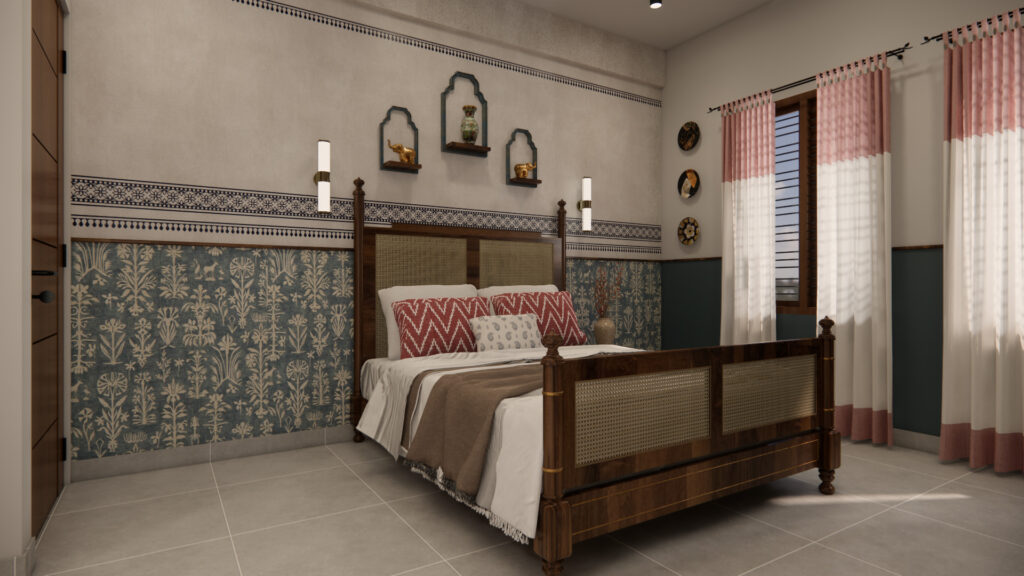
11. Traditional Elements with a Modern Twist
Blending traditional furniture with contemporary materials like acrylic or metal can create a modern twist on classic designs. This fusion combines heritage with clean lines and innovative finishes for a fresh, updated appeal.
Using traditional motifs in sleek, minimalist forms or incorporating modern materials into classic silhouettes can create a unique and stylish interior. This blend of old and new reflects a harmonious balance of tradition and innovation.
12. Courtyards and Gardens
Courtyards and gardens are essential elements of Indian interior design. A central open space adorned with fountains, colourful tiles, and lush greenery brings natural light and ventilation into the home, fostering a serene atmosphere.
Incorporating a courtyard with intricate jali work (lattice screens) and vibrant planters can create a tranquil oasis within the home. These elements not only enhance the aesthetic appeal but also provide a refreshing and calming environment.
13. Intricately Detailed Ceilings
Ornamental wood ceilings, featuring hand-carved beams adorned with floral, geometric, or religious motifs, add warmth and grandeur to interiors. These ceilings, often seen in traditional Indian palaces, showcase intricate craftsmanship and cultural richness.
Using detailed wooden ceilings in living rooms or dining areas can create a visually stunning and culturally significant space. These elements add depth and character, enhancing the overall design.
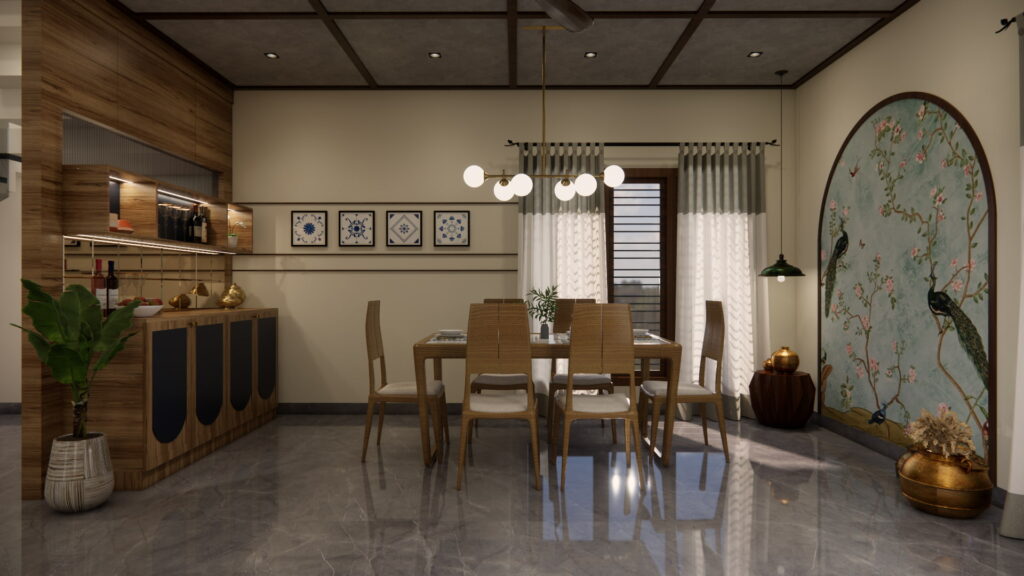
14. Cultural Artifacts and Collectibles
Showcasing cultural artifacts and collectibles, such as brass utensils, antique sculptures, and vintage textiles, adds a sense of history and richness to the space. These items reflect the cultural heritage and personal stories, making the interiors unique and meaningful.
Incorporating these artefacts into modern interiors can create a harmonious blend of old and new, adding depth and personality to the space. A collection of antique brass utensils or a framed vintage textile can become cherished focal points.
15. Symmetry and Balance
Symmetry and balance are key principles in Indian interior design. Symmetrical arrangements of furniture, paired with decorative items like matching lamps or artwork, create a harmonious layout. Traditional motifs repeated symmetrically in textiles, rugs, or wall designs contribute to a visually pleasing and culturally significant sense of equilibrium.
Using symmetrical designs and balanced layouts in living rooms or bedrooms can create a sense of order and harmony. These elements not only enhance the aesthetic appeal but also reflect the cultural significance of balance and symmetry.
At Tesor Designs, we celebrate the timeless beauty of Indian heritage in interior design. By blending traditional elements with modern sensibilities, we create spaces that exude warmth, cultural depth, and timeless allure. Each project is a tribute to the rich cultural tapestry of India, seamlessly integrating vibrant colours, intricate patterns, and handcrafted artistry into contemporary interior design. Whether you seek a luxury bedroom or a harmonious traditional interior design, we ensure that every detail is thoughtfully curated to reflect the essence of Indian heritage.

